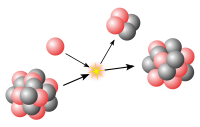| Nuclear physics |
|---|
 |
Photofission is a process in which a nucleus, after absorbing a gamma ray, undergoes nuclear fission and splits into two or more fragments.
The reaction was discovered in 1940 by a small team of engineers and scientists operating the Westinghouse Atom Smasher at the company's Research Laboratories in Forest Hills, Pennsylvania.[1] They used a 5 MeV proton beam to bombard fluorine and generate high-energy photons, which then irradiated samples of uranium and thorium.[2]
Gamma radiation of modest energies, in the low tens of MeV, can induce fission in traditionally fissile elements such as the actinides thorium, uranium,[3] plutonium, and neptunium.[4] Experiments have been conducted with much higher energy gamma rays, finding that the photofission cross section varies little within ranges in the low GeV range.[5]
Baldwin et al made measurements of the yields of photo-fission in uranium and thorium together with a search for photo-fission in other heavy elements, using continuous x-rays from a 100-MeV betatron. Fission was detected in the presence of an intense background of x-rays by a differential ionization chamber and linear amplifier, the substance investigated being coated on an electrode of one chamber. They deduced the maximum cross section being of the order of 5×10−26 cm2 for uranium and half that for thorium. In the other elements studied, the cross section must be below 10−29 cm2.[6]
YouTube Encyclopedic
-
1/2Views:6 98087 116
-
Mod-01 Lec-33 Nuclear Fission basics
-
Symmetric and Asymmetric Encryption Overview (Private Public Keys)
Transcription
Photodisintegration
Photodisintegration (also called phototransmutation) is a similar but different physical process, in which an extremely high energy gamma ray interacts with an atomic nucleus and causes it to enter an excited state, which immediately decays by emitting a subatomic particle.
References
- ^ Walter, Marni Blake (2015-09-01). "An Unlikely Atomic Landscape: Forest Hills and the Westinghouse Atom Smasher". Western Pennsylvania History Magazine. 98 (3). Senator John Heinz History Center: 36–49. Retrieved 2019-12-03.
- ^ Haxby, R.O.; Shoupp, W.E.; Stephens, W.E.; Wells, W.H. (1941-01-01). "Photo-Fission of Uranium and Thorium". Physical Review. 59 (1): 57–62. Bibcode:1941PhRv...59...57H. doi:10.1103/PhysRev.59.57.
- ^ Silano, J.A.; Karwowski, H.J. (2018-11-19). "Near-barrier Photofission in 232Th and 238U". Physical Review C. 98 (5): 054609. arXiv:1807.03900. Bibcode:2018PhRvC..98e4609S. doi:10.1103/PhysRevC.98.054609.
- ^ Doré, D; David, J-C; Giacri, M-L; Laborie, J-M; Ledoux, X; Petit, M; Ridikas, D; Lauwe, A Van (2006-05-01). "Delayed neutron yields and spectra from photofission of actinides with bremsstrahlung photons below 20 MeV". Journal of Physics: Conference Series. 41 (1). IOP Publishing: 241–247. Bibcode:2006JPhCS..41..241D. doi:10.1088/1742-6596/41/1/025. ISSN 1742-6588.
- ^ Cetina, C.; Berman, B. L.; Briscoe, W. J.; Cole, P. L.; Feldman, G.; et al. (2000-06-19). "Photofission of Heavy Nuclei at Energies up to 4 GeV". Physical Review Letters. 84 (25): 5740–5743. arXiv:nucl-ex/0004004. Bibcode:2000PhRvL..84.5740C. doi:10.1103/physrevlett.84.5740. ISSN 0031-9007. PMID 10991043. S2CID 206326581.
- ^ Baldwin, G. C.; Klaiber, G. S. (1947-01-01). "Photo-Fission in Heavy Elements". Physical Review. 71 (1). American Physical Society (APS): 3–10. Bibcode:1947PhRv...71....3B. doi:10.1103/physrev.71.3. ISSN 0031-899X.
